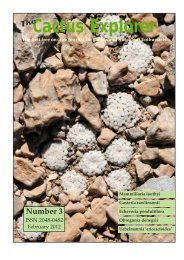Cactus Explorers Journal - The Cactus Explorers Club
Cactus Explorers Journal - The Cactus Explorers Club
Cactus Explorers Journal - The Cactus Explorers Club
Create successful ePaper yourself
Turn your PDF publications into a flip-book with our unique Google optimized e-Paper software.
Photo: G. Charles<br />
<strong>The</strong> <strong>Cactus</strong> Explorer ISSN 2048-0482 Number 4 May 2012<br />
In thE GlasshousE<br />
Strophocactus chontalensis<br />
<strong>The</strong>re is something really special about<br />
growing and flowering an unusual plant. It<br />
was my work on the New <strong>Cactus</strong> Lexicon<br />
which opened my eyes to the many genera<br />
which are rarely seen in British collections. It<br />
made me realise what I had been missing, but<br />
it has not been easy to find suppliers of these<br />
rare plants.<br />
Strophocactus chontalensis first came to my<br />
attention when Ralf Bauer wrote his ‘Synopsis<br />
of the tribe Hylocereeae’ published in No.17 of<br />
Cactaceae Systematics Initiatives (2003). But<br />
the story began in 1940 when Tom MacDougall<br />
first collected the plant near San Miguel<br />
Tenango, Oaxaca, Mexico. <strong>The</strong> description of<br />
the new species was delayed until 1950 due to<br />
the lack of flowers to complete the description.<br />
MacDougall wrote an article about some<br />
epiphytic cacti of the region in the American<br />
<strong>Journal</strong> (XVIII):147-150 (1946). He described<br />
how he re-found the plant referred to with his<br />
16<br />
field number A44, the ‘Tenango Cereus’,<br />
growing only on rocks, often with Epiphyllum<br />
crenatum. <strong>The</strong> pictures in this article, and in the<br />
continuation on pages 165-168, show that the<br />
plant makes very large tangled groups of<br />
stems, each up to about a metre long tumbling<br />
over rocks. Flowers from this visit were then<br />
available to complete the description.<br />
<strong>The</strong> plant was eventually described as<br />
Nyctocereus chontalensis by Alexander in the<br />
Photo: G. Charles




